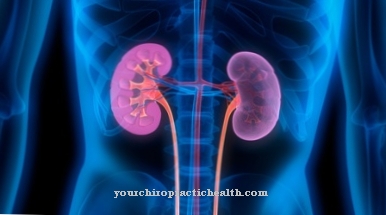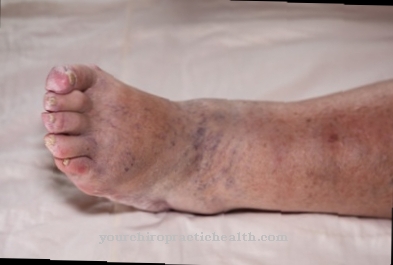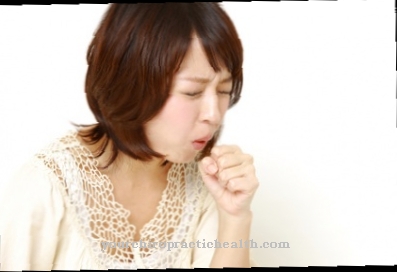Almost everyone knows Skin blisters from minor burns or after wearing new shoes. If you know the causes of a skin blister, it can be treated easily and in many cases even avoided in advance.
What is a skin blister?
.jpg)
A skin blister, also known as a bulla, is a pathological change in the skin in which fluid collects due to skin irritation and the skin area bulges visibly outwards.
This makes skin blisters one of the so-called efflorescences in dermatology. If blisters are at least 5 mm in size, they are called skin blisters or bullae. Smaller accumulations of fluid are called vesicles or vesicles in dermatology.
There are three types of skin blisters in medicine. Subcorneal blisters are those that lie under the horny layer, intraepidermal blisters are in the so-called epidermis, and blisters that lie under the dermis are called subdermal.
causes
Blisters appear as a result of excessive skin irritation. A particularly typical cause of a skin blister is friction, for example from footwear that does not fit properly or is too damp.
The friction creates heat that burns the skin. But skin blisters also develop after any other type of second-degree burn.This does not only apply to physical heat sources such as sun, fire or the like.
The causes of skin blisters can also be of a chemical nature. In addition to burns, bullae can also result from second-degree frostbite or infections. Usually a blister does not appear immediately but develops over a long period of time, sometimes after a few hours.
Diseases with this symptom
- Impetigo contagiosa
- Herpes simplex
- Shingles
- Polymorphic photodermatosis
- allergy
- Pemphigus foliaceus
- acne
- Rosacea
- Pemphigus vulgaris
- Cold sore
- Dermatitis herpetiformis Duhring
- Bullous pemphigoid
- anthrax
- combustion
- Autoimmune blistering dermatoses
Diagnosis & course
A skin blister is painful as long as it affects comparatively small areas of the skin, but is generally harmless to health. Treatment by a doctor is therefore usually not necessary.
Since the appearance of a blister is announced in advance by pain, the cause of the skin irritation can in many cases be eliminated and the formation of the blister prevented. If a blister can no longer be prevented, the top layers of the skin peel off and protein-poor tissue fluid is deposited.
If measures such as cooling or ointment are taken directly in the case of blisters, this can influence their formation and subsequent size. Once a bubble has formed, it takes time to go away. Usually, the skin has recovered after a few days. Broken skin blisters usually take a little longer to heal. However, skin blisters usually recede completely and do not leave any scars.
Complications
A skin blister is usually harmless and bursts on its own. But if you don't wait for it and open it yourself at home, you run the risk of infection. This complication occurs when sterile cutlery has not been used - which in turn is not easy to do at home. Boiling the tool in salt water or exposing it to a sufficiently high source of heat can kill germs, but if this is not done thoroughly, when the bulla is opened, the germs are placed exactly where they are particularly easy to cause infection.
The opened bladder becomes infected and since the affected area is already weakened, such infections usually do not subside on their own after a short time. If the skin blister is in an inconvenient place that normally needs to be stressed, this can also lead to complications. Blisters are particularly common on the foot, they arise precisely at the stress points.
If the skin blister is not opened, the affected person may no longer be able to appear properly and risks tension and incorrect strain on the muscles that he uses to replace movement. Since these muscles are not made for this, they react with pain and subsequent overload. To avoid this type of complication, it is often better to have the bladder opened by a doctor.
When should you go to the doctor?
_2.jpg)
People who notice skin changes with blisters should always consult a doctor (e.g. dermatologist). It could be a bacterial or viral skin infection, autoimmune disease, or food allergy. Immune-weakening skin diseases that cause blistering are called bullous dermatoses and are very rare.
In bullous dermatoses, the organism forms antibodies against cell components of its own skin. This loosens the top layer of skin and creates small or large blisters. The antibodies have a massive impact on the skin's stability, not only destroying the epidermis, but also deeper layers of the skin. There are several diseases that belong to the group of blistering dermatoses. They are all similar. If a bubble moves sideways within healthy tissue, it indicates a specific autoimmune disorder.
The doctor tests for antibodies (immunofluorescence) that can be detected in the skin cells and in the blood. If the blisters were caused by a bacterial infection, treatment with antibiotics is advisable. Sun or cold can damage the skin so severely that fluid-filled bubbles form. A common vesicular skin disease caused by viruses is herpes simplex type 1. It occurs primarily on the lips and can be very painful. Herpes simplex type 2 shows up in the genital area and is also caused by viruses.
Doctors & therapists in your area
Treatment & Therapy
Many people have a tendency to pierce a blister. But it is better to leave the bladder as it is. The skin of the bladder that stretches over the wound protects it from the penetration of bacteria.
As the healing process continues, the bladder also recedes. The healing process can be accelerated with various ointments from the pharmacy. Anyone who nevertheless decides to pierce a blister should choose a pointed and, above all, sterile object. It may be necessary to puncture a bladder if the bladder is, for example, under the sole of the foot or in other parts of the body where a blister cannot heal calmly.
After the wound water has drained from the pierced bladder, a blister plaster is stuck over the wound, which takes over the function of the bladder skin and protects the wound from possible infections. In some cases, the skin blisters can burst on their own. This is also not atypical and generally does not require treatment by a trained medical professional.
However, it can become problematic if the wound becomes infected. If bubbles burst, they reveal the dermis. Compared to the epidermis, the dermis is much lighter and more reddish and gives off wound water. This is the ideal breeding ground for bacteria of all kinds, which have easy access through the unprotected and exposed wound. If the wound becomes infected, a doctor must be consulted who will provide medical care for the wound.
Outlook & forecast
The prospects for the further course of a blister vary depending on the cause. Blisters that are caused by mechanical stress usually recede by themselves over time and heal without scarring. However, inflammation can also develop, especially if the outer skin of the bladder is damaged. If the blisters are detected early, they can usually be treated well with medicinal ointments.
Most of the time, scars can only remain if blisters are caused by intense radiation, burns or frostbite. If allergies are the trigger, the course depends on the strength of the allergic reaction. Since allergies usually last a lifetime, the only way to prevent the recurrence of blisters in this case is to avoid future contact with the allergenic substance.
Even if autoimmune diseases cause blistering, the prognosis is very different depending on the extent of the immune response. Treatment is essential because, if left untreated, these diseases can be fatal. Usually, drugs are used as therapy that reduce the immune activity that causes symptoms such as blistering. These immunosuppressants usually have to be taken for life, as the underlying autoimmune disease is usually not completely curable.
prevention
Before a blister appears, the affected area is already painful. In the case of blisters caused by mechanical friction, skin blisters can be avoided if the condition that caused the friction is eliminated directly.
Even in the case of blisters from burns, a blister can be prevented or at least the size of the blister can be reduced by directly cooling the affected area extensively. Blister plasters are also great not only for treating blisters, but also for prevention. However, the formation of blisters can also be completely prevented by avoiding the causes of skin blisters.
In many cases it is enough to change a few everyday things. So you should only wear suitable footwear with synthetic and well-fitting socks. Socks should also be changed regularly to avoid moisture in the shoe. If you can foresee that hiking or running will increase the stress on your feet, you should slowly get used to this stress in order to prevent skin blisters.
In order to reduce moisture through sweating, there are also so-called antihidrotics in the pharmacy, which can be applied to areas of the skin and thus reduce the release of sweat. Anyone handling fire or hot objects should wear protective clothing and be particularly careful around heat sources. In the household, oven gloves or the like are often sufficient to avoid minor burns.
You can do that yourself
Everyday and self-help is usually very possible when skin blisters appear. If the skin blister forms on the foot due to new footwear, preventive measures can be taken in advance. For example, the formation of a blister on the foot is announced by pain in the affected area and reddened skin appears. A preventive measure is to stick a plaster with soft padding on the reddened area or to put a little padding in the shoe itself. Special blister plasters are more suitable than a normal wound plaster. They are specially designed for pressure relief, pain relief, and sterile draping.
If the formation of blisters is to be expected after a scald from hot or boiling water, cooling the scalded skin helps to limit the inflammatory reactions that are initiated by the immune system. Existing skin blisters that can no longer be prevented in advance should, if possible, be given the opportunity to heal independently without opening them. If the bladder is very annoying, it can be opened carefully with a sharp object, such as a sewing needle. It is advisable to sterilize the needle tip beforehand with alcohol or by heating it in a lighter flame, because the tissue fluid in the bladder is an ideal breeding ground for many pathogenic germs.




.jpg)




















.jpg)

.jpg)
